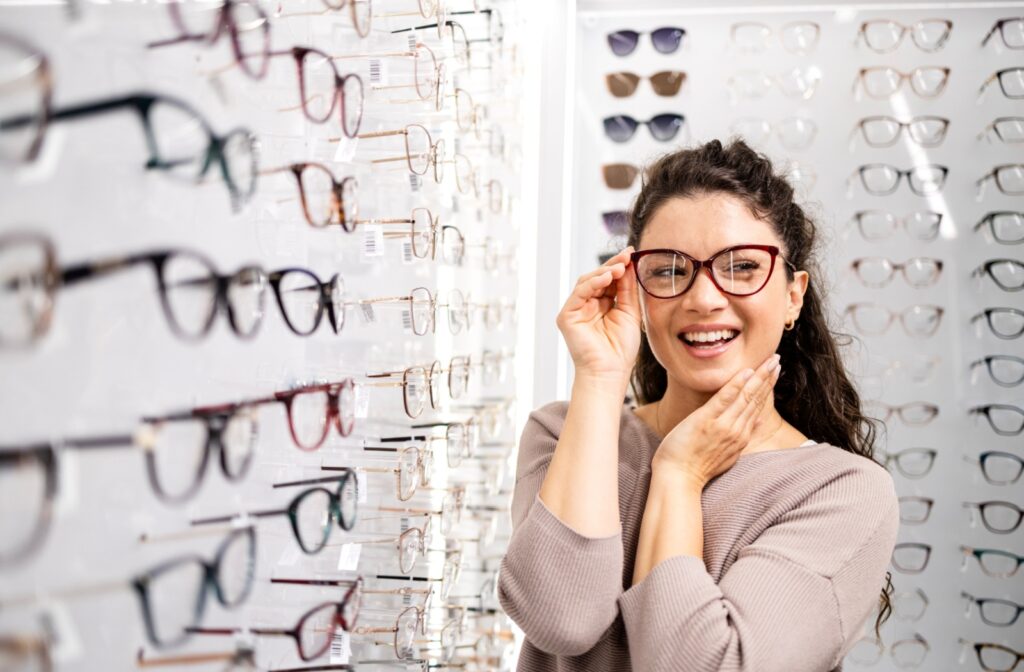Finding the perfect pair of glasses shouldn’t feel like searching for a needle in a haystack. The secret to choosing eyewear lies in understanding your face shape and selecting frames that complement your natural features. When you match your eyewear to your facial structure, you can see clearly and look fantastic doing it.
Many people can feel overwhelmed trying on different frames after they get an eye exam. But the good news is that once you know your face shape, selecting flattering glasses can become much simpler.
Why Face Shape Matters When Choosing Glasses
The right frames help create visual balance, while the wrong ones can throw off your entire look. Understanding this relationship between face shape and frame style helps you move beyond simply choosing glasses based on color or brand. Instead, you’ll make decisions based on what actually works with your unique facial structure.
How to Tell What Your Face Shape Is
Determining your face shape is easier than you might think. Start by pulling your hair back completely and looking straight into a mirror. You can also take a photo of yourself facing forward with good lighting.
Look at the overall outline of your face and consider these key measurements:
- The width of your forehead
- The width of your cheekbones
- The width of your jawline
- The length of your face from the forehead to the chin
Then, use the following descriptions to identify your shape:
Oval Face
- Face length is greater than the width of the cheekbones.
- Forehead is slightly wider than the jawline.
- Jawline is rounded.
- Overall, the face has soft angles and balanced proportions.
Round Face
- Cheekbones and face length are about the same size.
- Face is roughly as wide as it is long.
- Jawline is soft and rounded.
- Face appears circular with full cheeks.
Square Face
- Forehead, cheekbones, and jawline are almost the same width.
- Jawline is strong and angular.
- Face has a more boxy or broad appearance.
Diamond Face
- Face is longer than it is wide.
- Cheekbones are the widest part.
- Forehead and jawline are narrow.
- Chin is often slightly pointed.
Heart Face
- Forehead is the widest part of the face.
- Face tapers down to a narrow, often pointed chin.
- Cheekbones may be prominent.
- Resembles an upside-down triangle.
Once you compare your measurements and features to these descriptions, your face shape should become clear.

What Types of Eyeglasses Most Suit Different Face Shapes
Once you’ve identified your face shape, you can focus on frame styles that complement your features beautifully.
Oval Faces
Since your face is already well-proportioned, the goal is to maintain that balance. Rectangular frames work wonderfully because they complement your natural symmetry. Cat-eye frames can add a touch of vintage glamor, while round frames soften your features for a more casual look.
The key is choosing frames that are roughly the same width as the broadest part of your face. Avoid frames that are too large or too small, as they might disrupt your natural harmony.
Round Faces
If you have a round face, your goal is to add definition and create the illusion of length. Angular, geometric frames are your best friends because they provide contrast to your curved features.
Rectangular frames can work well, especially those with clear, defined lines. Square frames can also add the structure you’re looking for. Cat-eye frames with upswept angles can lift your features and create a flattering contrast.
Square Faces
With a square face, you have strong, defined features that can handle bold frame choices.
Round and oval frames are excellent choices because they provide a pleasing contrast to your angular jawline and forehead. Cat-eye frames can also work well, especially those with curved edges rather than sharp points.
Look for frames that are wider than your jawline to help balance your proportions.
Diamond Faces
Narrow foreheads and chins with wide cheekbones characterize diamond-shaped faces.
Cat-eye frames are particularly flattering because they add width to your upper face, balancing prominent cheekbones. Oval frames can also work well, providing gentle curves that complement your features.
Rimless frames or frames with decorative details on the top can draw attention upward and create better balance.
Heart Faces
Heart-shaped faces feature wide foreheads that narrow down to pointed chins.
Frames that are wider at the bottom, such as aviators or certain cat-eye styles, can work beautifully. Round frames can also help soften your features and create better balance.
Look for frames with interesting details or colors on the lower portion to draw attention downward.
Find Eyeglasses for All Face Shapes
While understanding your face shape can provide an excellent starting point, remember that personal style and comfort matter just as much. These guidelines are supposed to help you narrow down your options, not limit your choices.
The best way to find your perfect frames is to try on different styles and see how they look and feel on your face. What matters most is that you feel confident and comfortable in your glasses, since you’ll be wearing them every day.
A professional fitting can help your glasses not only look great but also sit comfortably and provide clear vision. Stop by and see us at Dr. Henslick Vision Center for a personalized fitting with our team. We’ll help you explore frame options that complement your face shape while helping your glasses fit perfectly and meet all your vision needs.




